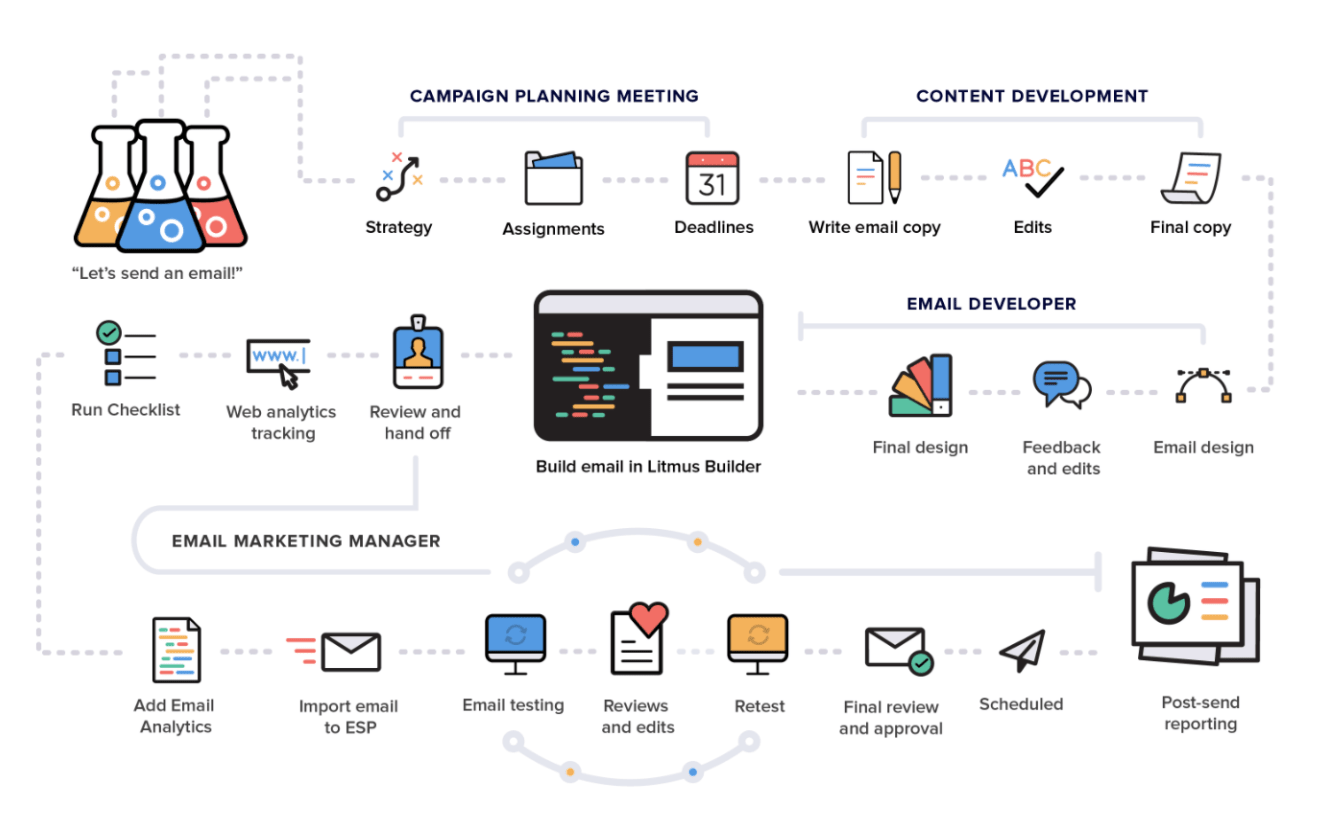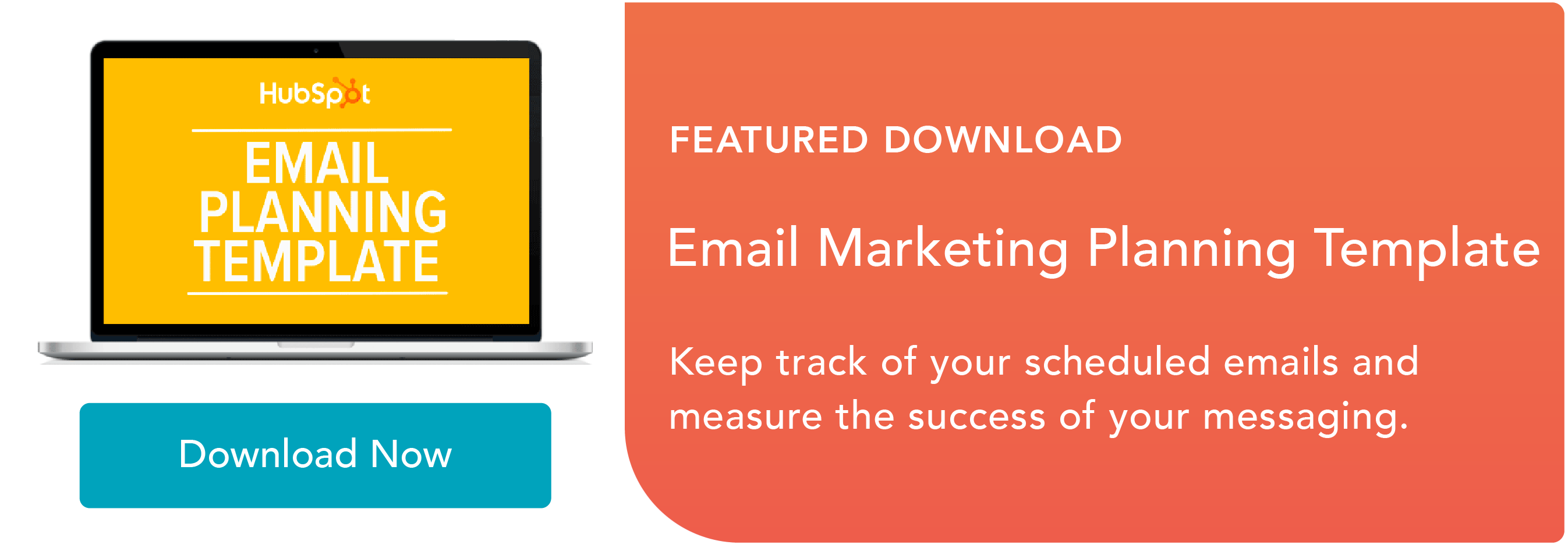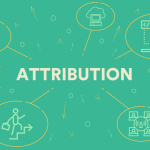- Like
- SHARE
- Digg
- Del
- Tumblr
- VKontakte
- Flattr
- Buffer
- Love This
- Save
- Odnoklassniki
- Meneame
- Blogger
- Amazon
- Yahoo Mail
- Gmail
- AOL
- Newsvine
- HackerNews
- Evernote
- MySpace
- Mail.ru
- Viadeo
- Line
- Comments
- Yummly
- SMS
- Viber
- Telegram
- JOIN
- Skype
- Facebook Messenger
- Kakao
- LiveJournal
- Yammer
- Edgar
- Fintel
- Mix
- Instapaper
- Copy Link
“Hey, would you mind sending a follow-up email?”
You’re already barely keeping up with your workload when you get the dreaded, last-minute email request.
With everything else on your plate, you now need to pause to get that second email out the door, and then play catch-up with everything else on your plate…
Sound familiar?
We know you’re constantly being asked to send more emails with less resources.
And sometimes, it’s unavoidable. When your business’ and subscribers’ needs change, you must be able to adapt quickly to stay relevant or risk your email marketing program suffering.
But that doesn’t mean it has to be so difficult.
Enter agile email marketing.
Here, let’s break down what agile email marketing means, why it matters, and how you can use it to scale and send more effective emails faster — without breaking a sweat.
What is agile email marketing, anyway?
Agile email marketing is a way to be flexible and adapt to change by focusing on data and your subscribers’ needs while using a modular process so you can send effective emails faster.
Before diving deeper into agile email marketing, we first have to mention the agile methodology.
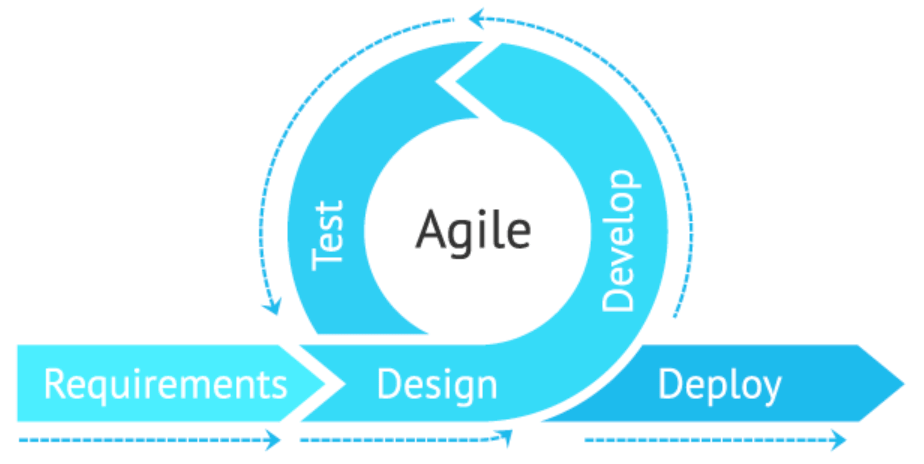
The agile methodology is a project management process that started in software development, giving teams the flexibility to adapt and respond to changes quickly. This way, teams could constantly improve and innovate, staying on top of their users’ needs and beating their competition to market.
There are many ways this agility is possible, but the three things we carry over into agile email marketing are:
- Focusing on customer needs
- Making data-driven decisions
- Collaborating across teams
So while agile email marketing doesn’t require using the agile methodology, it takes its essence to create a more efficient way to send emails.
In other words, agile email marketing helps you prioritize your emails, gets all stakeholders on the same page, and maximizes your teams and resources to streamline your production process. With teamwork and a clear understanding of goals, you won’t bat an eye at last-minute email sends or changing priorities.
Sound too good to be true?
Agile email marketing does require a shift in mindset — instead of planning the big campaigns you’re used to, you’ll need to plan for iterative change in a test-and-learn environment.
For example, instead of mapping out and creating all the emails in your entire welcome or onboarding journey, start small with only the first email. Do some A/B testing to figure out what your audience is most receptive to, optimize, and use what you learn to continue building out the rest of your nurture journey — one email at a time.
Your goal is progress, not perfection. But don’t worry, this shift isn’t all or nothing. Even the smallest steps toward changing how you think about emails and the workflow to become agile can have huge payoffs, as I’ll explain next.
Why Being Agile is Critical to Success
Sure, email professionals may seem like magicians, but emails aren’t done with the wave of a wand. There’s a lot that goes on under the hood. 52% of marketers spend two weeks or more to complete a single email from conception to hitting the send button.
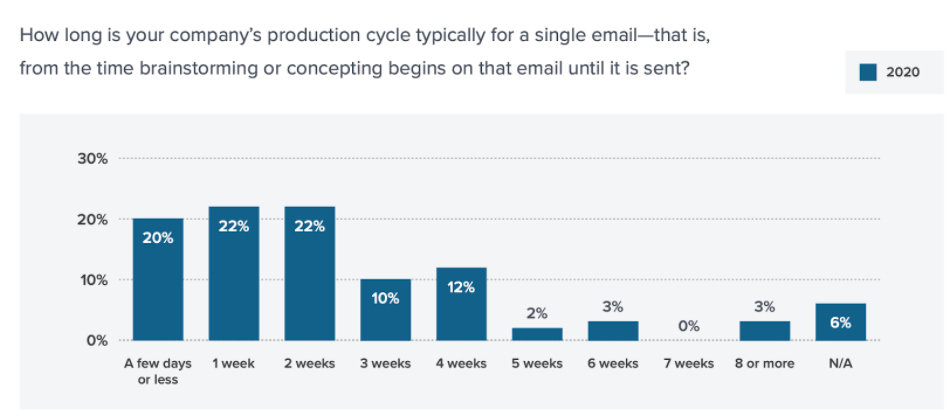
Source: Litmus’ 2020 State of Email Workflows
Not to mention, 55% of marketers are juggling at least six emails at a time. So it’s never “just” one more email.
The traditional email marketing process uses linear and interdependent steps. You can’t move forward without completing the step before. For example, you need to write copy before creating imagery, or have design done before coding the email.
Look at that process! It’s no wonder it can take a long time to create and send an email.
But this pace can hurt your email marketing program — or worse, your brand reputation. Things can change in an instant … Think natural disasters, a health crisis, the socio-political climate, rules and regulations, etc. If you can’t adapt, your email campaign may fall flat or even offend and turn away your subscribers.
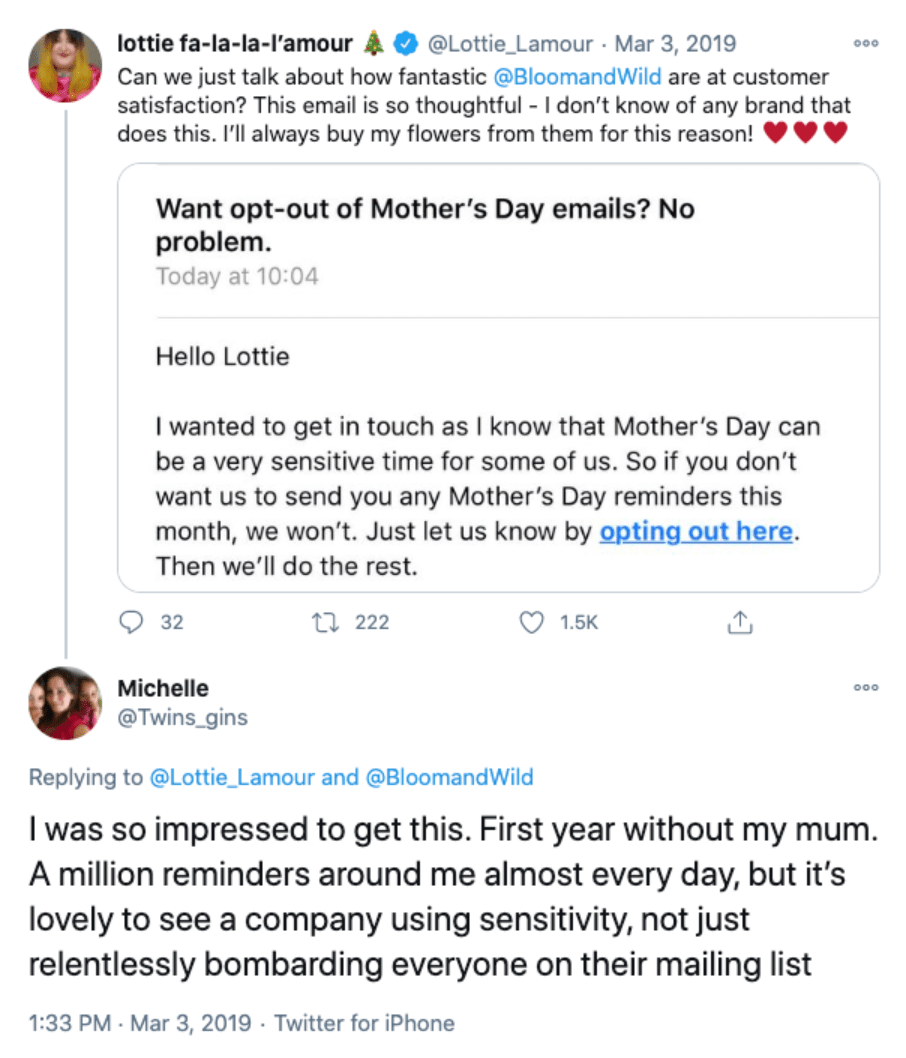
Empathy is crucial, and being agile keeps you attuned to your subscribers’ needs so you can pivot at a moment’s notice — and keep your customers for the long-haul. This also gives your work purpose.
You know you’re always delivering the highest value work instead of falling into the trap of the sunk cost fallacy: continuing work that’s not relevant or worth it anymore simply because of what you’ve already invested in it. Your work is no longer about you, it’s about your subscribers!
Even if you’re in no rush, if your competitor is just one day ahead of you, that can put you at a significant disadvantage. An agile email marketing workflow gives you greater speed to market which can be just the edge you need for campaign success.
How to Make Your Email Workflow Agile
So how do you go from a linear email workflow to an agile one?
You’ll first need to start with your audience and put them at the center of your campaigns, make data-driven decisions, and collaborate across roles and teams.
With these tenets in mind, you can begin building a new workflow that allows many parts of your email marketing process to be either automated or done in tandem, as shown in this agile email workflow chart:
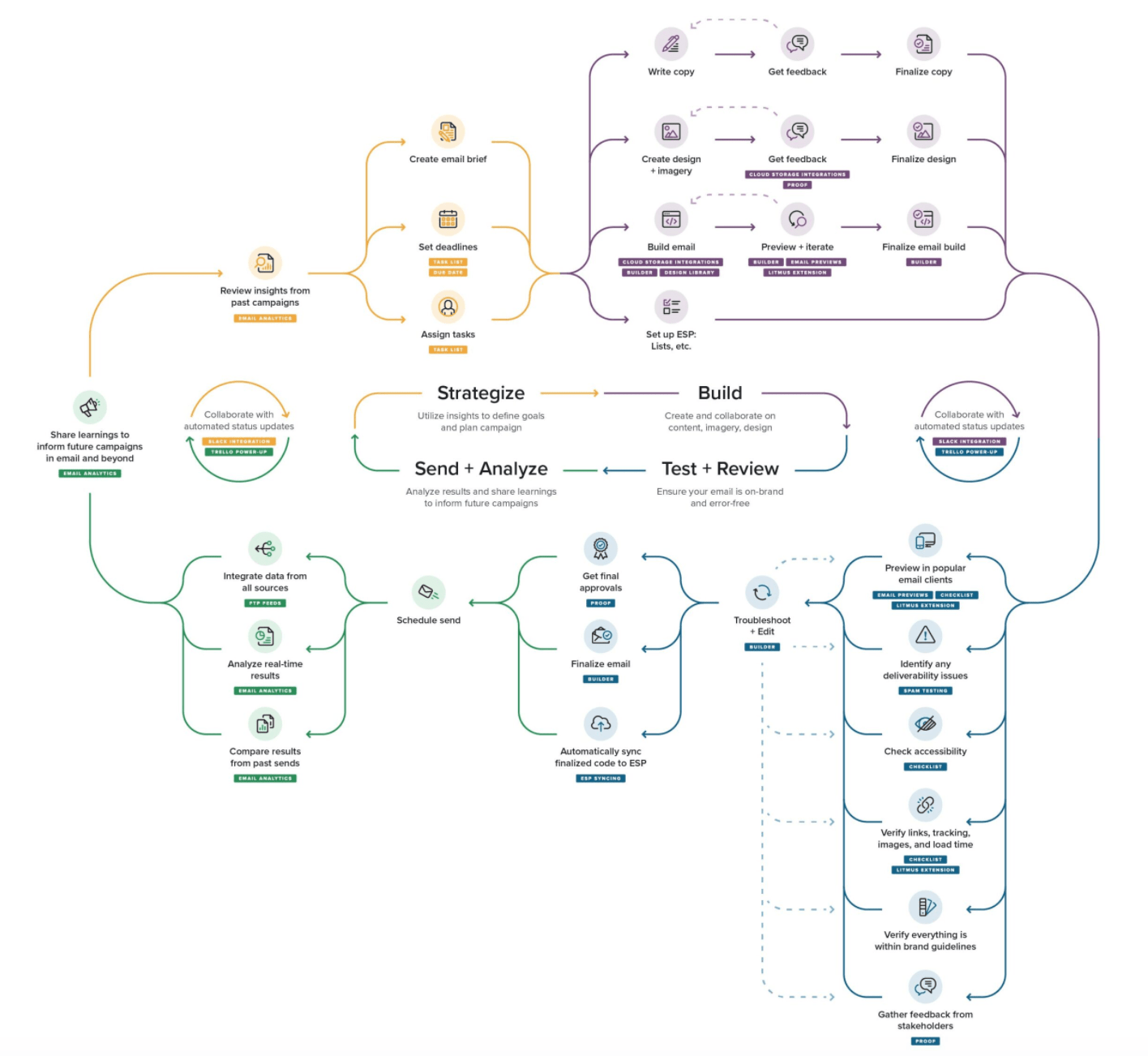
Ready? Let’s dive into how you can go agile.
1. Get your team and tools in place.
Crucial to the success of agile email marketing is your people and your tools. Without this strong foundation, you’ll more likely face challenges with adoption.
Make an assessment of the skills and tools needed so you know who to tap to join you and how you can get emails done together.
Cross-Team Collaboration
One of the cornerstones of agile email marketing is cross-team collaboration, which means taking advantage of a wide variety of existing roles and skills already within your company to create and send emails.
That’s right: You don’t have to hire new people or have a large, dedicated email team. Instead, by leveraging other people’s strengths and, if needed, running through email marketing best practices to hone their craft specifically for email, you can work efficiently as a team. Make sure you communicate your needs and get everyone on board, first!
The skills you need will depend on your email marketing program, but the main ones to consider are:
- Strategy
- Copywriting
- Design
- Development
- Operations
- Analysis
In one scenario, for instance, you might want to pull people from your content and website teams to help with copywriting, design, and development.
Tools and Technology
The second part of an agile email marketing foundation is the tools.
Make an assessment of your current technology and review the rest of the agile email workflow steps below to see where your gaps are. Do you have what you need to send emails, simplify and automate steps in your process, and collaborate effectively across teams?
At the very least, you need an email marketing tool and a collaboration tool.
2. Align on email strategy.
With your team and tools in place, you need to make sure everyone — including reviewers and approvers — is on the same page, setting your team up for success as you all work toward a common goal.
A solid strategy ensures copy, design, and development are aligned. Without alignment, there can be miscommunication and confusion. And this can slow you down or throw your email off track, resulting in even more work and time wasted. Not agile at all.
If putting together an email marketing brief stresses you out, know that it doesn’t have to be complicated or extensive. As long as you have these basics, you’re golden:
- Define your email’s purpose, goal, and audience.
- Define your content strategy for getting opens and clicks.
- Define the hierarchy of your email’s copy and images.
Remember the key to being agile is your subscribers. When their needs intersect with your business’ needs, you get… magic.

If you find that your email doesn’t meet your subscribers’ needs, consider changing your email — or not sending it at all.
Continuous improvement is essential to being agile, and you can re-center your email around your subscribers by learning from the past and present to inform your future strategy.
You can extract insights from industry news or your email marketing tools to identify design improvement opportunities or improve segmentation, targeting, and personalization.
Now that everyone’s expectations are set and in sync, email production can begin.
3. Write, design, and build at the same time.
The time it takes to write, design, and build an email adds up in a linear process. When they’re each done in tandem, it’s like cutting production time by over 50%.
The secret? Standardized email design and a visual email editor.
Creating every email from scratch is a huge waste of time. And if you want to ensure brand consistency and reduce errors, standardized emails are the way to go.
There are a few ways of doing this, in order of complexity:
- Snippets: reusable lines of code for commonly used elements like HTML buttons or hyperlinks so you don’t have to code the same thing over and over again.
- Partials: reusable lines of code for globally-used content blocks like your header and footer so any updates made to them are automatically applied across every email.
- Templates: reusable coded emails with a set layout on which to simply add or replace copy, images, and links.
- Design systems: a collection of reusable email components with a guide on how they can be mixed and matched to create more flexible — yet still standardized — email designs.
This doesn’t mean you have to settle for boring, ho-hum designs. You can still be creative in your imagery and in how different reusable components come together to create an email.
Standardized email design and development not only frees up your time for innovation, but also sets the stage for being able to write, design, and build at the same time within a visual email editor.
Once a template has been defined for your email, then you already have the specifications for the copy that needs to be written and the images that need to be created. Then, it’s a matter of plugging them into your email template.
Loaded with your email snippets, partials, and/or template, a visual email editor tool can then empower everyone to work on their part of the production process at the same time and collaborate along the way.
Images can be created based on the content outline in your email marketing brief from step two, while the copy is being written. Copy can even be written within your visual email editor to help ensure it’ll fit inside the design, making copy edits a breeze.
Even if you don’t have a visual email editor, development can begin with placeholder images and text. With everyone on the same page on strategy, there’s no need to wait for design and copy first.
4. Collect feedback in one place.
With email strategy alignment across all stakeholders, the review process should be less painful. Still, juggling feedback can be difficult coming from different people across different tools. What if there are contradicting comments? Or you miss an important piece of feedback altogether?
This time-saving tip is simple: Consolidate everyone’s feedback in one place.
Stop sending individual screenshots or test emails. Share one email test with stakeholders in a single location so everyone’s collaborating together.
First, you’ll need to grab the URL in the “view in browser” or “view online” link of your email. You can also create a web-based version of your email to share. The important thing is that you have an email where people can test links and interactive elements.
Then, pick a single spot — not an email thread — to share your email for feedback. This could be as part of a group message in your communication tool or as a single task in your project management tool.
You could collect feedback in those same places. Or you might find it faster and easier to create a separate spreadsheet to track feedback, conversations on specific comments, as well as progress on implementing feedback.
The key thing is that all reviewers and approvers are together and can see each other’s feedback.
There are also tools made specifically for collaboration where you can not only share a live version of your email, but also leave feedback directly on it, check off when changes are made, and track approvals.
5. Analyze & share insights.

After your email is sent, see how it’s performing so you can evolve to meet your subscribers’ needs. In the agile methodology world, you might consider this the end of a sprint, working in small increments to improve the success of your emails.
The email marketing metrics you should look at depends on your goal. Your email marketing tools will provide at least the basics — opens, clicks, and unsubscribes — and may even provide deeper engagement-level metrics like how long someone spent reading your email (read rate) or how many people shared your email (forward rate).
If you’re tempted to skip this step, don’t.
Email analysis tends to be what people skip if they’re short on time. Onto the next email, right? In the long run, though, this hurts your email marketing program.
It might be hard to believe, but analyzing your emails will actually save you time. It’s what makes agile email marketing work in the first place. If you remember, I mentioned that being agile relies on data, whether that’s internal (e.g. email performance) or external (e.g. the news).
Data is how you can keep a pulse on your subscribers’ preferences, and how those preferences might change over time.
It gives you the power to say no to the emails that don’t matter. Otherwise, you’re shooting in the dark and wasting time on emails your subscribers don’t care about. And this affects your company’s brand reputation, and bottom line.
Final Thoughts on Going Agile
Remember, even achieving some agility in your email workflow has its rewards, like giving your team some time back or being able to quickly flex to your subscribers.
While there’s nothing wrong with the linear email marketing process —completing one step at a time — you won’t be able to move as fast in today’s ever-changing environment. To rise above your competition and ensure you always meet your subscribers where they are, you need speed and efficiency. That’s where agile email marketing comes in.
Make sure you have the right team and tools in place with everyone on the same page on strategy. Then you can be off and running to create great emails in no time.
So the next time someone asks if you can send just one more email, you can confidently say ‘No’ (because it’s not the right fit for your subscribers), or embrace it with open arms (because it is the right fit for your subscribers). Either way, it won’t be your workflow holding you back.
Originally published Mar 2, 2021 7:00:00 AM, updated March 02 2021


